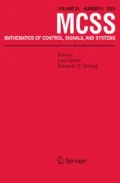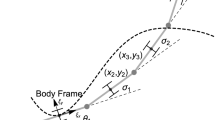Abstract
We study a model for snake-like robots based on the Fibonacci sequence. The present paper includes an investigation of the reachable workspace, a more general analysis of the control system underlying the model, its reachability and local controllability properties. In addition, we establish some fractal properties of the reachable workspace by means the theory of iterated function systems.






Similar content being viewed by others
Notes
Notice that \(L(\mathbf u)=L(\mathbf u,\mathbf v)\) for all \(\mathbf v\in \{0,1\}^\infty \) where \(L(\mathbf u,\mathbf v):=\sum _{n=1}^\infty |x_n(\mathbf u,\mathbf v)-x_{n-1}(\mathbf u,\mathbf v)|\).
Actually, we prove that such a neighborhood is indeed a polygon which is symmetric with respect to the origin.
Indeed the claim immediately follows by recalling the equality \(\{L(\mathbf u)\mid \mathbf u\in \{0,1\}^\infty \}=R_\infty (q)\).
References
Anderson VV, Horn RC (1967) Tensor-arm manipulator design. Am Soc Mech Eng 67-DE-75:1–12
Baillieul J (1986) Avoiding obstacles and resolving kinematic redundancy. IEEE Int Conf Robot Autom 3:1698–1704
Ball P (1999) The self-made tapestry: pattern formation in nature. Oxford University Press, Oxford
Burdick JW (1988) Kinematic analysis and design of redundant robot manipulators. Stanford University, Diss
Chirikjian GS, Burdick JW (1990) An obstacle avoidance algorithm for hyper-redundant manipulators. IEEE Int Conf Robot Autom 1:625–631
Chirikjian GS, Burdick JW (1995) The kinematics of hyper-redundant robot locomotion. IEEE Trans Robot Autom 11(6):781–793
Choset H, Henning W (1999) A follow-the-leader approach to serpentine robot motion planning. J Aerosp Eng 12(2):65–73
Chitour Y, Piccoli B (2001) Controllability for discrete control systems with a finite control set. Math Control Signal Syst 14:173–193
Ebert-Uphoff I, Chirikjian GS (1996) Inverse kinematics of discretely actuated hyper-redundant manipulators using workspace densities. IEEE Int Conf Robot Autom 1:139–145
Erdös P, Komornik V (1998) Developments in non-integer bases. Acta Math Hungar 79(1–2):57–83
Falconer K (2013) Fractal geometry: mathematical foundations and applications. Wiley, New York
Gilbert WJ (1981) Geometry of radix representations. The geometric vein. Springer, New York, pp 129–139
Gilbert WJ (1987) Complex bases and fractal similarity. Ann Sci.Math Québec 11(1):65–77
Indlekofer K-H, Kátai I, Racskó P (1992) Number systems and fractal geometry. Probability theory and applications. Springer, The Netherlands, pp 319–334
Hutchinson J (1981) Fractals and self-similarity Indiana Univ. J Math 30:713–747
Komornik V, Loreti P (2007) Expansions in complex bases. Can Math Bull 50(3):399–408
Kwon SJ, Chung WK, Youm Y, Kim MS (1991) Self-collision avoidance for n-link redundant manipulators. Proceedings of the IEEE international conference on system, man and cybernetics, Charlottesville, USA, pp 937–942
Lai AC (2012) Geometrical aspects of expansions in complex bases. Acta Math Hung 136(4):275–300
Lai AC, Loreti P (2011) Robot’s finger and expansions in non-integer bases. Netw Heterog Media 7(1):71–111
Lai AC, Loreti P (2014) Robot’s hand and expansions in non-integer bases. Discret. Math. Theor Comput Sci 16(1):371–394
Lai AC, Loreti P (2012) Discrete asymptotic reachability via expansions in non-integer bases. Proceedings of 9-th international conference on informatics in control, automation and robotics
Lai AC, Loreti P, Vellucci P (2014) A model for robotic hand based on fibonacci sequence. Proceedings of the 11-th international conference on informatics in control, automation and robotics, pp 577–587
Liu J, Wang Y, Ma S, Li B (2004) Shape control of hyper-redundant modularized manipulator using variable structure regular polygon. Intell Robots Syst 4:3924–3929
Park AE, Fernandez JJ, Schmedders K, Cohen MS (2003) The Fibonacci sequence: relationship to the human hand. J Hand Surg Am 28(1):157–160
Parry W (1960) On the \(\beta \)-expansions of real numbers. Acta Math Acad Sci Hungar 11:401–416
Rényi A (1957) Representations for real numbers and their ergodic properties. Acta Math Acad Sci Hung 8:477–493
Wille J (2012) Occurrence of Fibonacci numbers in development and structure of animal forms: Phylogenetic observations and epigenetic significance. Nat Sci 4:216–232
Author information
Authors and Affiliations
Corresponding author
Rights and permissions
About this article
Cite this article
Lai, A.C., Loreti, P. & Vellucci, P. A Fibonacci control system with application to hyper-redundant manipulators. Math. Control Signals Syst. 28, 15 (2016). https://doi.org/10.1007/s00498-016-0167-4
Received:
Accepted:
Published:
DOI: https://doi.org/10.1007/s00498-016-0167-4



